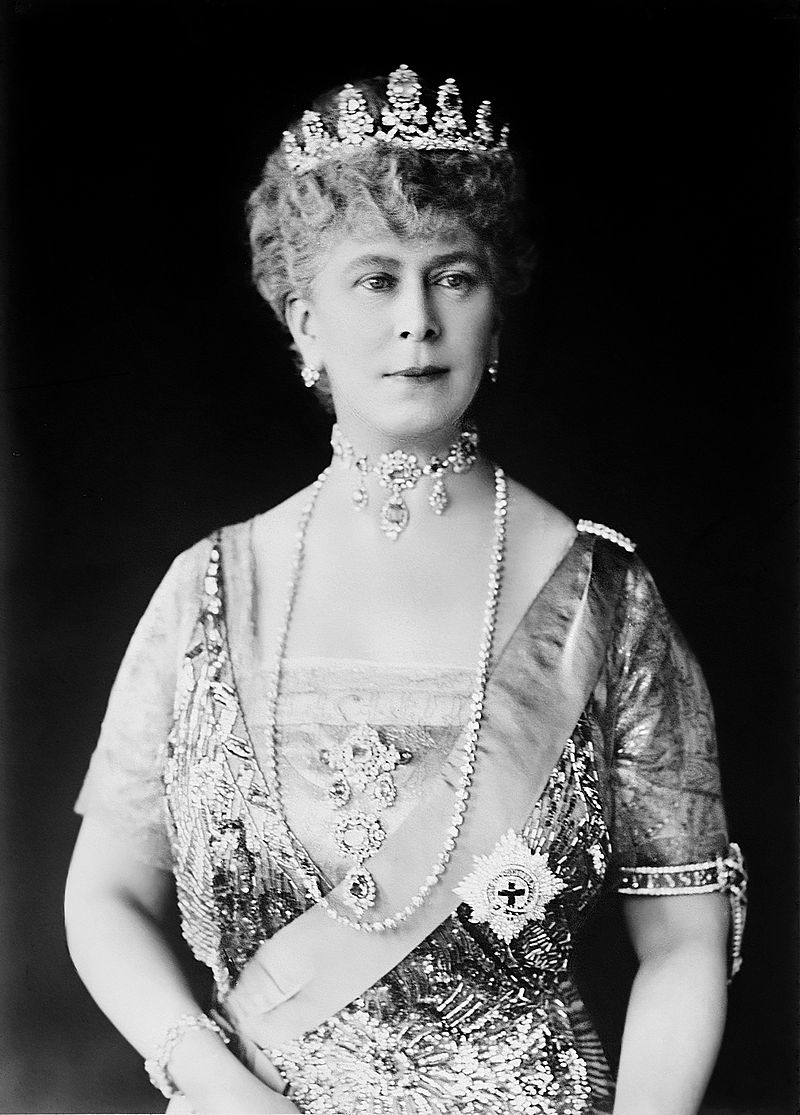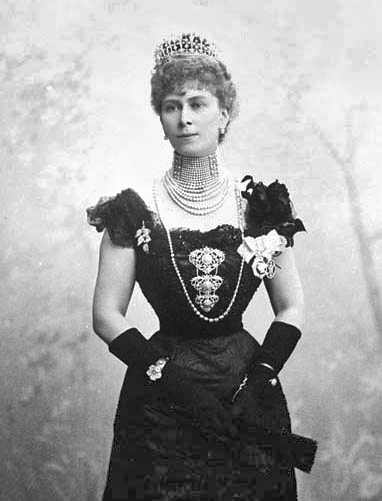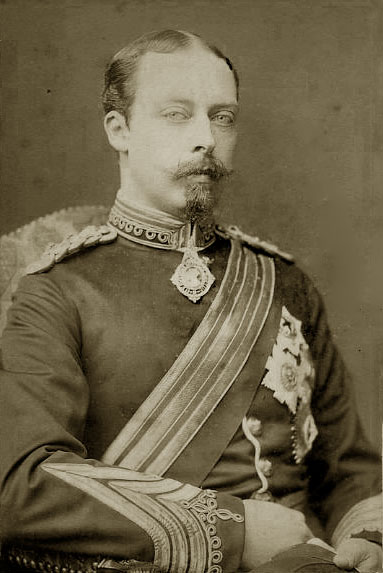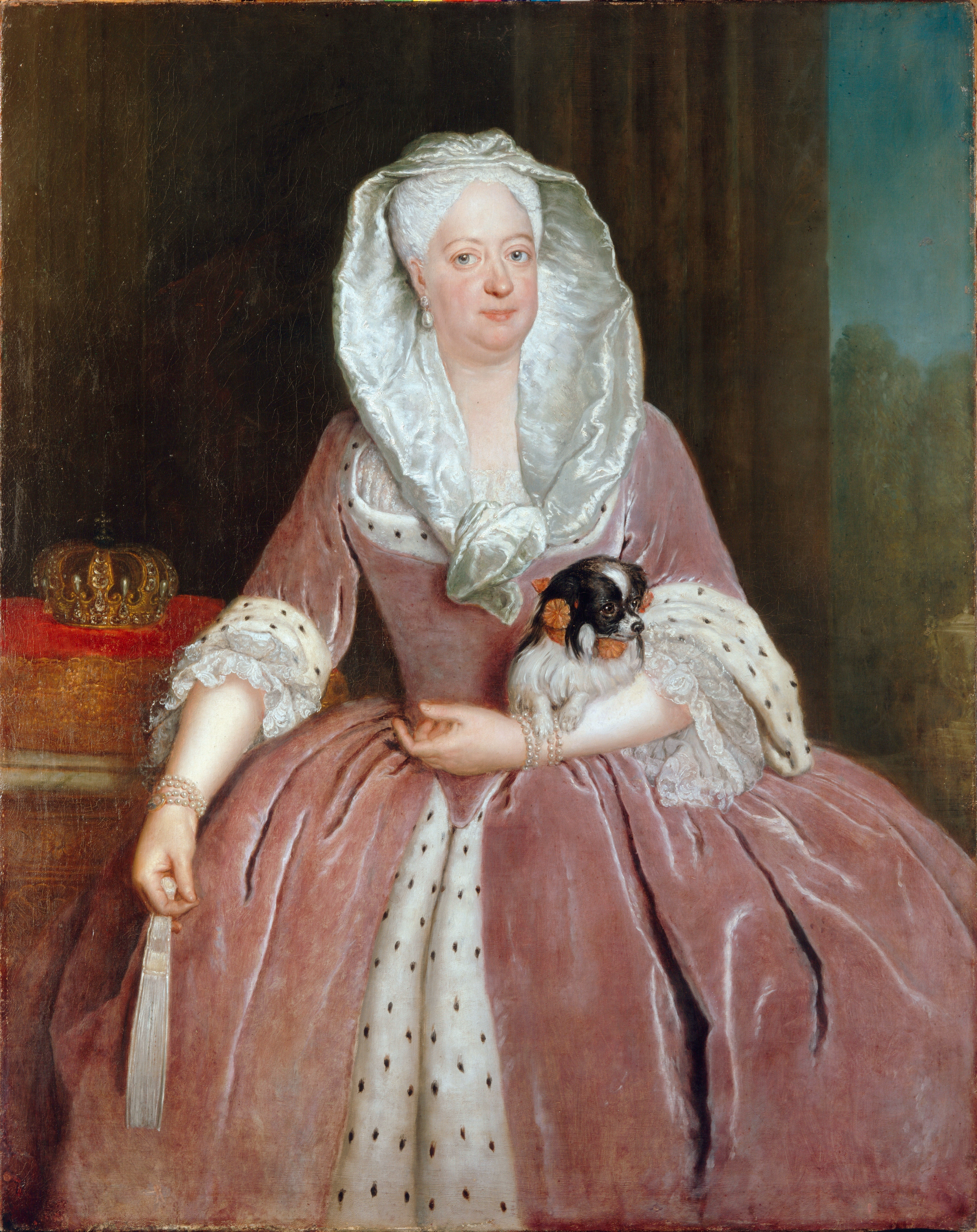by Susan Flantzer © Unofficial Royalty 2013

Mary of Teck, Queen of the United Kingdom; Credit – Wikipedia
Her Serene Highness Princess Victoria Mary Augusta Louise Olga Pauline Claudine Agnes of Teck (known as Mary or May) was born at Kensington Palace, London on May 26, 1867. She was the eldest of the four children and the only daughter of Prince Francis, Duke of Teck, and Princess Mary Adelaide of Cambridge. Mary was christened at the Private Chapel in Kensington Palace by Charles Thomas Longley, Archbishop of Canterbury on July 27, 1867. Her godparents were:

The infant Mary with her parents; Credit – Wikipedia
Mary’s mother was a male-line granddaughter of King George III and a first cousin of Queen Victoria. Princess Mary Adelaide weighed approximately 250 pounds and was affectionately known as “Fat Mary.” Queen Victoria wrote of her, “Her size is fearful. It is really a misfortune.” Princess Mary Adelaide, however, was high-spirited and full of life, and was adored by the Victorian public who called her “The People’s Princess.”
Mary’s father was His Serene Highness Prince Francis of Teck, the product of a morganatic marriage. Prince Francis’ father, Duke Alexander of Württemberg, was once heir to the throne of Württemberg. However, Duke Alexander contracted a morganatic marriage (marriage to a person of a lower rank) to a Hungarian countess, Claudine Rhedey. Duke Alexander lost his rights to the throne and his children lost the right to use the Württemberg name. Francis’ cousin King Karl of Württemberg eventually elevated him to the more important Germanic title of Duke of Teck.
Mary Adelaide and Francis had a happy marriage but had chronic financial problems due to Mary Adelaide’s extravagance and generosity. Queen Victoria gave them an apartment at Kensington Palace where their four children were born. Mary had three younger brothers:

Queen Mary with her mother and brothers by Alexander Bassano, half-plate glass negative, circa 1884 NPG x96004 © National Portrait Gallery, London
Mary spent her first sixteen years in London. The Tecks were always in financial difficulties, and in 1883 fled from their creditors to the European continent where it was cheaper to live. The family lived with various relatives in Europe and eventually settled in Florence, Italy where Mary acquired an interest in art that would remain with her throughout her life. In 1885, the family returned to London.
Mary was first engaged to Prince Albert Victor, Duke of Clarence (known as Prince Eddy), the oldest son and eldest child of Albert Edward, Prince of Wales (later King Edward VII) and Princess Alexandra of Denmark. Backward and lazy, Eddy had been an apathetic student and received very little education. He was primarily interested in pursuing pleasure which often led him into trouble. His lack of concentration on anything serious caused great concern in his family. Eddy’s family decided that finding a suitable wife might help correct his attitude and behavior.

Prince Albert Victor, Duke of Clarence and Avondale; Queen Mary when Princess Victoria Mary of Teck by Gunn & Stuart, albumen cabinet card, 21 December 1891, NPG x29174 © National Portrait Gallery, London
Unbeknownst to her, Mary was considered the most suitable bride for Eddy. Eddy offered no resistance to this suggestion. Mary had been brought up to revere the monarchy and to be proud that she was a member of the British Royal Family. The fact that Mary’s father was a product of a morganatic marriage could have presented difficulties for her in the marriage market. Despite Eddy’s shortcomings, Mary felt it was her duty to marry him. The engagement was announced on December 6, 1891, and the wedding was set for February 27, 1892. A month after the engagement announcement, Prince Eddy became ill with influenza. Within a few days, his lungs became inflamed and pneumonia was diagnosed. He died on January 14, 1892.
After Prince Eddy’s death, Mary and his brother George, the future King George V, now second in the line of succession after his father, spent much time together. As time passed and their common grief eased, there was hope that a marriage might take place between them. George proposed to Mary beside a pond in the garden of his sister Louise’s home, East Sheen Lodge, on April 29, 1893. The engagement was announced on May 3, 1893, with the blessing of George’s grandmother Queen Victoria, and the couple married on July 6, 1893, at the Chapel Royal in St. James’ Palace.

Wedding of Mary and George, standing from left to right: Alexandra of Saxe-Coburg and Gotha, Helena Victoria of Schleswig-Holstein, Victoria Melita of Saxe-Coburg and Gotha, Prince George, Victoria of Wales, Maud of Wales; sitting from left to right: Alice of Battenberg, Margaret of Connaught, Mary of Teck; front row: Beatrice of Saxe-Coburg and Gotha, Victoria Eugénie of Battenberg and Patricia of Connaught; Credit – Wikipedia

George and Mary on their wedding day; Credit – Wikipedia
George and Mary had six children:
- King Edward VIII (Duke of Windsor after his abdication) (1894-1972), married Wallis Simpson, no children
- King George VI (1895-1952), married Lady Elizabeth Bowes-Lyon, had two daughters
- Mary, Princess Royal (1897-1965), married Henry Lascelles, 6th Earl of Harewood, had two sons
- Prince Henry, Duke of Gloucester (1900-1974), married Lady Alice Montagu-Douglas-Scott, had two sons
- Prince George, Duke of Kent, (1902-1942), married Princess Marina of Greece, had two sons and one daughter
- Prince John (1905-1919)
In 1901, after the accession of King Edward VII, George and Mary toured the British Empire, visiting Malta, Ceylon (now Sri Lanka), South Africa, Australia, New Zealand, and Canada. In 1906, they toured India and then traveled to Spain for the wedding of George’s first cousin Princess Victoria Eugenie of Battenberg to King Alfonso XIII of Spain. Soon afterward, George and Mary traveled to Norway for the coronation of King Haakon VII, George’s first cousin, and Queen Maud, George’s sister.

Mary in 1901; Credit – Wikipedia
On May 6, 1910, George’s father King Edward VII died and George became King. George and Mary’s coronation was held at Westminster Abbey on June 22, 1911. See Unofficial Royalty: Coronation of King George V and Queen Mary. In December 1911, King George V and Queen Mary traveled to India for the Delhi Durbar where they were presented as Emperor and Empress of India. In 1919, George and Mary’s youngest child 13-year-old Prince John, who had epilepsy, died after a very severe seizure, most likely from Sudden Unexpected Death in Epilepsy or SUDEP.
On May 6, 1935, King George V and Queen Mary celebrated their Silver Jubilee. George was a heavy smoker and was already very ill at that time. He died on January 20, 1936, and was succeeded by his eldest son, King Edward VIII. King Edward VIII abdicated less than a year later and his brother Prince Albert, Duke of York ascended the throne, taking the regnal name George VI. King George VI was followed on the throne by his daughter Queen Elizabeth II.
During World War II, King George VI wanted to evacuate his mother from London. Mary was very reluctant, but eventually, she went to live with her niece Mary, Duchess of Beaufort, the daughter of her brother Adolphus, at Badminton House in Gloucestershire. Mary annoyed her niece by having the ivy torn from the walls of Badminton House because she considered it ugly and a health hazard. In 1942, Mary’s son Prince George, Duke of Kent was killed in an airplane crash while on active service. See Unofficial Royalty: Tragedy in the British Royal Family at the End of August.
In 1952, King George VI died. Queen Mary had lived long enough to see her granddaughter Elizabeth become queen, but died on March 24, 1953, at age 85 of lung cancer (although her illness was referred to as “gastric problems”) just ten weeks before the coronation. Before her death, Queen Mary had insisted that the coronation go ahead as scheduled. Mary was buried in St. George’s Chapel at Windsor Castle with her husband King George V.
Embed from Getty Images
Tomb of King George V and Queen Mary in St. George’s Chapel, Windsor
This article is the intellectual property of Unofficial Royalty and is NOT TO BE COPIED, EDITED, OR POSTED IN ANY FORM ON ANOTHER WEBSITE under any circumstances. It is permissible to use a link that directs to Unofficial Royalty.
House of Windsor Resources at Unofficial Royalty



























